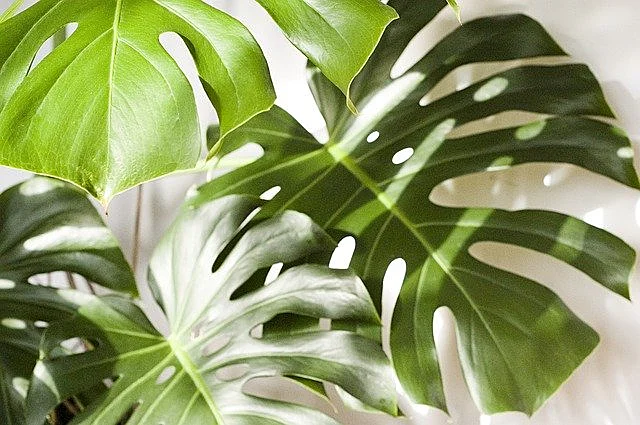Why Is My Monstera Leaf Drooping? You’re probably wondering the same thing. But don’t worry, you’ve come to the right place.
Drooping Monstera leaves are most often caused by a lack of water. They prefer their soil to be somewhat damp most of the time.
Overwatering, inadequate lighting, fertilizer issues, pests, or transplant shock are some of the other possible reasons. The first critical step in bringing your Monstera plant back to good health is identifying the issue.
Read More: Monstera Leaves Care – A Complete Guide
Table of Contents
Why Is My Monstera Leaf Drooping?
Observe the health of your Monstera carefully if you see wilting leaves or the plant as a whole drooping, and refer to the care instructions to determine what’s wrong.
The good thing is that this plant is highly resilient, and if you give it the appropriate care, it will quickly recover its strength.
Now let’s take a closer look at each of the probable causes of Monstera leaf drooping.
Underwatering
Get the watering right the first time might be challenging for individuals who are new to caring for houseplants. Some plants need a lot of water, while others require very little — and what exactly is the proper quantity of water?
Knowing where your plant comes from may tell you a lot about the climate it requires, and these plants originated from Southern mexico, where they live in damp tropical woods. They most certainly do not thrive in dry soil.
Overwatering
Overwatering your Monstera plant is possible, although less common than underwatering. It will immediately show you how uncomfortable it is by growing weak-looking yellow foliage, generally beginning with the lower foliage first, or by displaying brown dried-out spots at the leaves tips.
A decaying scent from the soil may also indicate the existence of root rot, which is really bad.
To find out whether you’ve been overwatering, repeat the finger test on the soil. Once you have ensured that there is enough drainage and that the pot has a hole at the bottom, you should allow the plant to dry out.
When watering your Monstera plant, you should wait till the top 2 inches of soil are dry before rewatering. If the plant container is on a saucer, ensure it isn’t regularly filled up.
Another typical cause of excessive moisture is over-potting the plant. It’s easy to believe that if you put your plant in a larger container with more potting soil, it’ll have more room to grow.
Instead, the additional soil absorbs more water, causing the container to become soggy. A wet sponge-like effect occurs when the soil around the roots is moistened. In order to avoid overwatering your plants, always put them into the next larger pot available to them.
Read More: How do you fix droopy Monstera?
Soil
It is possible to buy soil moisture meters, although their accuracy varies and they aren’t mandatory. As a rule of thumb, you’re better off putting your fingers into the soil and checking for dampness. However, the soil should stay cooler and wetter below those first two inches.
Your plant may need a thorough watering if it is not. When watering your plant, you may either water from the top or the bottom, as long as you get all of the soil soaked.
- Half-fill a basin with water and submerge your plant for 10–20 minutes to water from the bottom.The soil will gradually absorb water via the mechanism of capillary action.
- Watering from the top of a plant might result in a lot of the water passing through the potting medium, rather than being retained by the soil. To combat this, apply a small amount of water at a time, giving the soil enough time to absorb it.
Leave the pot to drain any surplus water from the drainage holes after you are satisfied that your soil is moist enough. Wipe the plants’ leaves with a wet cloth to remove any dust, and then set the container back where it came from.
Lighting Problems
Although these plants are very tolerant, keep in mind that they come from the forest and hence need lots of light but little direct sunlight.
If you see dried brown spots on your Monstera leaves, it means your plant is receiving too much direct sunlight, and you should transfer it to a more suitable location.
With low light, your Monstera plant will become stretched, with sparse leaves, and more susceptible to drooping and languishing. Either bright light or partial shade is excellent.
Both the health and the growth of your plant are directly influenced by the amount of light it receives.
Temperature Stress
It is important to bear in mind that although Monstera plants are quite forgiving, they are tropical plants and do not enjoy it when it gets too cold. The recommended temperature range is 64 to 84 degrees Fahrenheit (18 to 29 degrees Celsius).
Keep an eye out for any sources of cold drafts that may be causing stress to your Monstera plant and causing the leaves to droop.
Using a temperature sensor to record the lowest and highest temperatures for a few days and moving your plant as required will help you determine whether there is a problem with the temperature.
Read More: should i cut off drooping monstera leaves
Fertilizer Problems
To support their growth, these plants need a lot of nutrients. They may easily hit a height of 60 feet in the wild, however when kept in containers, they rarely exceed a reasonable 9 feet.
This kind of growth demands a consistent supply of nutrients, so:
- feed them twice a month with a general-purpose fertilizer throughout all months except during the winter months. One feed each month is sufficient during the slower-growing winter season.
- Applying too much fertilizer too often may lead to a buildup in the soil, which can cause root toxicity.
- Your Monstera plant may droop if the roots stop functioning and the plant is unable to receive the water and nutrients it requires.
- Observe the soil for indications of salt buildup from fertilizer, and take note of the fertilization plan you’ve been following.
- If you fear you’ve gone a bit far, run water through the soil for 5 to 10 minutes to flush it out. This will aid in the dissolution of surplus fertilizer salts and their removal from the soil.
- Repotting your Monstera into new soil and resuming a more cautious fertilization routine is an alternative to the former.
Transplant Stress
Your Monstera will grow quickly once it is comfortable with its growth conditions. A greater pot will be required at some point in the future. To avoid transplant shock, use a pot that is only a few inches bigger than the one in which the plant was previously housed.
This reduces the possibility of waterlogging while also ensuring that growth does not get out of control.
Occasionally, houseplants might show adverse reactions to repotting, leading to transplant stress. It’s more probable that your Monstera leaves would droop after being repotted if the plant’s roots were harmed during the repotting procedure.
Unless the roots are diseased, you don’t need to loosen the root ball while repotting them. To ensure that your Monstera fits into its new place, pay extra attention to it for several weeks following repotting.
Lack Of Support
You’ll need to provide your Monstera plant with something to cling to if you want it to continue growing upwards as it does in the wild.
So, instead of crawling about the room looking for anything to climb, your Monstera will stay upright. This may be done using moss poles.
If your plant begins to expand, it may be looking for more sunlight. When plants aren’t getting enough light, they don’t generate those distinctive slits in their leaves that are so common in the monstera.
Lack of light causes the leaves to stay tiny and feeble-looking, since they do not grow slits. As soon as you relocate the plant to a location that receives more natural light, the issue will be resolved.
Pests
Mealy bugs and red spider mites are the most common sap-sucking pests that attack most indoor foliage plants.
The first and most crucial defense is always observation.
The damage to the leaves caused by a severe pest infestation will force your Monstera to lose a lot of water and nutrients, which will force the whole plant to droop and die.
Keep an eye out for pests on the upper and lower surfaces of leaves on a regular basis since it is much simpler to kill them if you catch them early on.
Conclusion
Why Is My Monstera Leaf Drooping?
The first thing to check if your Monstera leaves are drooping is your watering. Examine your plant and its surroundings for any indicators of a problem once you’ve eliminated this as a possible cause.
Pixabay로부터 입수된 justynafaliszek님의 이미지 입니다.


